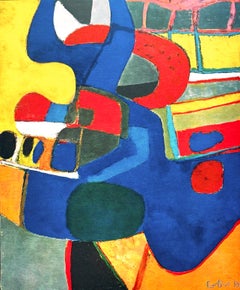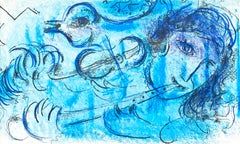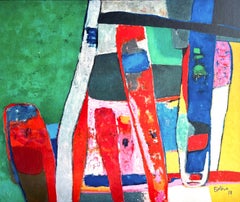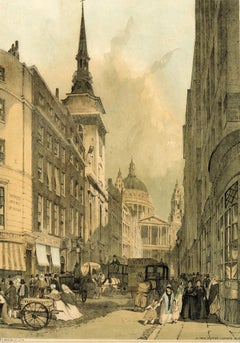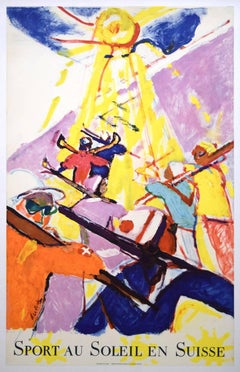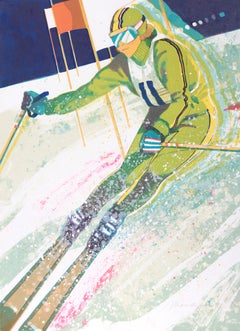Lithograph Landscape Prints
to
4,080
4,151
1,410
1,092
426
159
Overall Width
to
Overall Height
to
2,725
582
564
505
253
244
232
168
32
22
21
11
4
4
140
131
125
71
58
8
1,015
5,880
342
30
102
235
219
443
1,106
1,318
970
581
240
5
4,077
3,070
77
3,703
1,807
1,736
989
953
907
808
562
557
471
398
378
327
253
245
243
211
208
196
191
7,246
3,454
2,572
1,381
1,285
466
1,601
5,532
1,227
Medium: Lithograph
Estève, Centre dominé, Maurice Estève, Peintres d'aujourd'hui (after)
Located in Auburn Hills, MI
Héliogravure on vélin paper. Paper Size: 13.78 x 10.83 inches. Inscription: Signed in the plate and unnumbered, as issued. Notes: From the folio, Maurice Estève, Peintres d'aujourd'h...
Category
1960s Modern Lithograph Landscape Prints
Materials
Lithograph
$716 Sale Price
20% Off
Le Joueur de Flûte (Cramer 34; Mourlot 197), Chagall
By Marc Chagall
Located in Auburn Hills, MI
Lithograph on vélin paper. Paper Size: 9.06 x 15.75 inches, with centerfold, as issued. Inscription: Unsigned and unnumbered, as issued. Catalogue raisonné references: Chagall, Marc,...
Category
1950s Expressionist Lithograph Landscape Prints
Materials
Lithograph
$956 Sale Price
20% Off
Estève, L'Aumance, Maurice Estève, Peintres d'aujourd'hui (after)
Located in Auburn Hills, MI
Héliogravure on vélin paper. Paper Size: 10.83 x 13.78 inches. Inscription: Signed in the plate and unnumbered, as issued. Notes: From the folio, Maurice Estève, Peintres d'aujourd'h...
Category
1960s Modern Lithograph Landscape Prints
Materials
Lithograph
$716 Sale Price
20% Off
St. Paul's From Ludgate Hill, from Original Views of London As It Is
Located in Middletown, NY
Lithograph with hand tinting on heavy wove paper, full margins. Significant condition issues in the margins which include adhesive residue, edge tears and minor edge losses. The image area is clean with minor mat tone, however, colors are slightly attenuated. The verso shows moderate uneven toning. Issues primarily exist outside of the image area. This large and lively work was printed by Charles Hullmandel.
_______
The images in Boys's 1842 portfolio, Original Views of London...
Category
Mid-19th Century English School Lithograph Landscape Prints
Materials
Handmade Paper, Watercolor, Lithograph
Original Poster Sport au Soleil en Suisse - Hans Falk Switzerland Alps Skiing
By Hans Falk
Located in London, GB
Hans Falk (1918-2002)
Sport au Soleil en Suisse
Original Vintage Poster - lithograph (1957)
40x25"
Signed in the plate, and showing a procession of brightly-coloured skiers heading ...
Category
1950s Modern Lithograph Landscape Prints
Materials
Lithograph
Skier, Pop Art Lithograph by Alan Mardon
Located in Long Island City, NY
Skier
Allan Mardon, Canadian (1931)
Date: Circa 1980
Lithograph, signed and numbered in pencil
Edition of 300
Size: 29 in. x 21 in. (73.66 cm x 53.34 cm)
Category
1980s American Impressionist Lithograph Landscape Prints
Materials
Lithograph
The Yacht "Henrietta" 205 Tons. Modelled by Mr. Wm. Tooker, N.Y. Built by Mr. ..
By Charles Parsons
Located in New York, NY
Title continues: Built by Mr. Henry Steers, Greenpoint, L. I. Owned by Mr. James Gordon Bennett, Jr. Winner of the Great Ocean Yacht Race, With the ...
Category
1860s American Realist Lithograph Landscape Prints
Materials
Lithograph
Coffee Shop of Cairo, Egypt: Original 19th C. Lithograph by David Roberts
Located in Alamo, CA
This is an original 19th century duotone lithograph entitled "The Coffee-Shop of Cairo" by David Roberts, from his Egypt and Nubia volumes of the large folio edition, published in Lo...
Category
1840s Realist Lithograph Landscape Prints
Materials
Lithograph
Le coq rouge (Cramer 34; Mourlot 203), Chagall
By Marc Chagall
Located in Auburn Hills, MI
Lithograph on vélin paper. Paper Size: 9.06 x 15.75 inches, with centerfold, as issued. Inscription: Unsigned and unnumbered, as issued. Catalogue raisonné references: Chagall, Marc,...
Category
1950s Expressionist Lithograph Landscape Prints
Materials
Lithograph
$956 Sale Price
20% Off
Monoprint Monotype American Modernist Gregory Amenoff Abstract Expressionist
Located in Surfside, FL
Gregory Amenoff (Contemporary American abstract painter, b. 1948),
Monotype Monoprint (1990)
Hand signed in pencil lower right
plate: 16 x 16 inches
frame dimensions: 35 1/8 x 29 1/8 x 1 5/8 inches, wood frame with glazing
Provenance: Corporate Collection of Bank BNP Paribas
Gregory Amenoff is a painter who lives in New York City and Ulster County, New York. He is the recipient of numerous awards from organizations including the American Academy of Arts and Letters, National Endowment for the Arts, New York State Council on the Arts and the Tiffany Foundation. He has had over fifty one-person painting exhibitions in museums and galleries throughout the United States and Europe. His work is in the permanent collections of more than thirty museums, including the Whitney Museum of American Art, the Museum of Fine Arts in Boston, the Museum of Modern Art in New York and the Metropolitan Museum of Art. His work has the influence of both Abstract Expressionism and Pop Art in it, biomorphic forms in rich hues and thick textures with heightened colors and abstracted, organic forms, late American Modernism. He moved to New York in 1979, the artist rose to critical acclaim in the 1980s alongside Terry Winters, Bill Jensen, and Katherine Porter. The artist lives and works between New York, NY and his Hudson Valley residence. He works in woodcut, lithograph and monoprint techniques.
He was a collaborating artist illustrating Bradford Morrow, Bestiary along with Joe Andoe, James Brown, Vija Celmins, Louisa Chase, Eric Fischl, Jan Hashey, Michael Hurson, Mel Kendrick, James Nares, Ellen Phelan, Joel Shapiro,
Kiki Smith, David Storey, Michelle Stuart, Richard Tuttle, Trevor Winkfield, Robin Winters. Linoleum cuts with
pochoir and woodcuts for the Grenfell Press, New York. Amenoff served as President of the National Academy of Design from 2001-2005. He is a founding board member of the CUE Art Foundation in New York City and serves as the CUE Art Foundation's Curator Governor. Amenoff has taught at Columbia for the last eighteen years, where he holds the Eve and Herman Gelman Chair of Visual Arts and is currently the Chair of the Visual Arts Division in the School of the Arts. He is currently the Vice-President of the National Academy.
In 2011 he received the John Solomon Guggenheim Fellowship.
Museum Collections
Albright-Knox Art Gallery; Buffalo, NY
Art Institute of Chicago; IL
Baltimore Museum of Art;
Brooklyn Museum of Art; Brooklyn, NY
Butler Institute of American Art; Youngstown, OH
Cleveland Museum of Art; Cleveland, OH
Currier Gallery of Art; Manchester, NH
Frances and Sidney Lewis Foundation; Richmond, VA
Hood Museum of Art; Hanover, NH
Honolulu Academy of Art; Honolulu, HW
Kemper Museum of Contemporary Art; Kansas City, MO
Maier Museum of Art; Lynchburg, VA
Metropolitan Museum of Art; New York, NY
Milwaukee Museum of Art; Milwaukee, WI
Minneapolis Institute of Art; MN
Muscarelle Museum of Art, College of William and Mary; Williamsburg, VA
Museum of Fine Arts; Boston, MA
Museum of Modern Art; New York, NY
National Museum of American Art; Washington, DC
Neuberger Museum, State University of New York at Purchase; NY
New York Public Library, Spencer Collection...
Category
1980s American Modern Lithograph Landscape Prints
Materials
Lithograph, Monoprint, Monotype
Chien aboyant à la lune (Mourlot 189), Verve: Revue Artistique et Littéraire
By Joan Miró
Located in Auburn Hills, MI
Lithograph on vélin des Papeteries du Marais paper. Paper Size: 14 x 20.50 inches, with centerfold, as issued. Inscription: Signed in the plate and unnumbered, as issued. Catalogue r...
Category
1950s Surrealist Lithograph Landscape Prints
Materials
Lithograph
$1,996 Sale Price
20% Off
Braque, Composition, Derrière le miroir (after)
Located in Auburn Hills, MI
Lithograph on vélin paper. Inscription: Unsigned and unnumbered, as issued. Good condition, with centerfold, as issued. Notes: From Derrière le miroir, N° 166, 1967. Published by Aim...
Category
1960s Modern Lithograph Landscape Prints
Materials
Lithograph
$716 Sale Price
20% Off
Composition (Cramer 22; Mourlot 515), Société internationale d'art XXe siècle
By Joan Miró
Located in Auburn Hills, MI
Lithograph on vélin paper. Paper Size: 12.4 x 28.95 inches, with bifold, as issued. Inscription: Unsigned and unnumbered, as issued. Catalogue raisonné references: Cramer, Patrick, a...
Category
1960s Surrealist Lithograph Landscape Prints
Materials
Lithograph
"In the Beginning There Were Mistakes" Gallery Poster
Located in Chesterfield, MI
"In the Beginning There Were Mistakes" is a Gallery Poster featuring the artwork of CHARLES BRAGG (American, b. 1931). The print measures 28 x 22 inches and is unframed. It is Plate-...
Category
Late 20th Century Lithograph Landscape Prints
Materials
Lithograph
$128 Sale Price
20% Off
W H Tittel Rastkogelhütte Original Vintage Skiing Climbing Travel Poster Austria
By W.H. Tittel
Located in London, GB
To see our other original vintage travel posters, many of which have skiing subjects, scroll down to "More from this Seller" and below it click on "See all from this seller" - or sen...
Category
1930s Modern Lithograph Landscape Prints
Materials
Lithograph
Picasso, Composition, Pablo Picasso, Toros Y Toreros (after)
Located in Auburn Hills, MI
Héliogravure on vélin paper. Paper Size: 14.75 x 10.5 inches. Inscription: Unsigned and unnumbered, as issued. Notes: From the album, Pablo Picasso, Toros y toreros, 1961. Published ...
Category
1960s Cubist Lithograph Landscape Prints
Materials
Lithograph
$716 Sale Price
20% Off
Autoportrait (Cramer 43; Mourlot 282), The Lithographs of Chagall
By Marc Chagall
Located in Auburn Hills, MI
Lithograph on vélin paper. Paper Size: 12.216 x 9.875 inches. Inscription: Unsigned and unnumbered, as issued. Catalogue raisonné references: Cain, Julien, and Fernand Mourlot. Chaga...
Category
1960s Expressionist Lithograph Landscape Prints
Materials
Lithograph
$956 Sale Price
20% Off
Mud Flat, Contemporary Lithograph by Dennis Oppenheim
Located in Long Island City, NY
Artist: Dennis Oppenheim
Title: Mud Flat
Year: 1977
Medium: Lithograph, signed and numbered in pencil
Edition: 100
Size: 41 in. x 29 in. (104.14 cm x 73.66 cm)
Category
1970s Conceptual Lithograph Landscape Prints
Materials
Lithograph
Sandscapes #4 Florida Artist Abstract Modernist Signed Print
By Kathy Stark
Located in Surfside, FL
Fine piece of Florida abstract Landscape art. With a French Art Deco feel to it.
Category
1990s American Modern Lithograph Landscape Prints
Materials
Lithograph
Composition (Dupin 1312), Société internationale d'art XXe siècle
By Joan Miró
Located in Auburn Hills, MI
Lithograph, stencil on vélin paper. Paper Size: 12.4 x 9.65 inches. Inscription: Signed in the plate and unnumbered, as issued. Catalogue raisonné references: Dupin, Jacques, et al. ...
Category
1950s Surrealist Lithograph Landscape Prints
Materials
Lithograph
$796 Sale Price
20% Off
Lake Tahoe Panorama, Nautical Landscape Cyanotype in Blue, Minimal Water Art
By Kind of Cyan
Located in Barcelona, ES
This is an exclusive handprinted limited edition cyanotype.
"Lake Tahoe Panorama" shows a sequence of abstracted ripples of the calm Tahoe waters.
Details:
+ Title: Lake Tahoe Panor...
Category
2010s Minimalist Lithograph Landscape Prints
Materials
Emulsion, Watercolor, C Print, Color, Engraving, Lithograph, Photogram
Estève, Friselune, Maurice Estève, Peintres d'aujourd'hui (after)
Located in Auburn Hills, MI
Héliogravure on vélin paper. Paper Size: 10.83 x 13.78 inches. Inscription: Signed in the plate and unnumbered, as issued. Notes: From the folio, Maurice Estève, Peintres d'aujourd'h...
Category
1960s Modern Lithograph Landscape Prints
Materials
Lithograph
$716 Sale Price
20% Off
Estève, Sioule, Maurice Estève, Peintres d'aujourd'hui (after)
Located in Auburn Hills, MI
Héliogravure on vélin paper. Paper Size: 10.83 x 13.78 inches. Inscription: Signed in the plate and unnumbered, as issued. Notes: From the folio, Maurice Estève, Peintres d'aujourd'h...
Category
1960s Modern Lithograph Landscape Prints
Materials
Lithograph
$716 Sale Price
20% Off
Estève, Neige, Maurice Estève, Peintres d'aujourd'hui (after)
Located in Auburn Hills, MI
Héliogravure on vélin paper. Paper Size: 13.78 x 10.83 inches. Inscription: Signed in the plate and unnumbered, as issued. Notes: From the folio, Maurice Estève, Peintres d'aujourd'h...
Category
1960s Modern Lithograph Landscape Prints
Materials
Lithograph
$716 Sale Price
20% Off
Estève, Le Lithographe, Maurice Estève, Peintres d'aujourd'hui (after)
Located in Auburn Hills, MI
Héliogravure on vélin paper. Paper Size: 13.78 x 10.83 inches. Inscription: Signed in the plate and unnumbered, as issued. Notes: From the folio, Maurice Estève, Peintres d'aujourd'h...
Category
1960s Modern Lithograph Landscape Prints
Materials
Lithograph
$716 Sale Price
20% Off
Estève, Le Faucheur, Maurice Estève, Peintres d'aujourd'hui (after)
Located in Auburn Hills, MI
Héliogravure on vélin paper. Paper Size: 13.78 x 10.83 inches. Inscription: Signed in the plate and unnumbered, as issued. Notes: From the folio, Maurice Estève, Peintres d'aujourd'h...
Category
1960s Modern Lithograph Landscape Prints
Materials
Lithograph
$716 Sale Price
20% Off
Estève, La Tapisserie, Maurice Estève, Peintres d'aujourd'hui (after)
Located in Auburn Hills, MI
Héliogravure on vélin paper. Paper Size: 10.83 x 13.78 inches. Inscription: Signed in the plate and unnumbered, as issued. Notes: From the folio, Maurice Estève, Peintres d'aujourd'h...
Category
1960s Modern Lithograph Landscape Prints
Materials
Lithograph
$716 Sale Price
20% Off
Black/White Lithograph American Modernist Gregory Amenoff Abstract Expressionist
Located in Surfside, FL
Gregory Amenoff (Contemporary American abstract painter, b. 1948),
Title: Haven, STATE II
Lithograph, 1986
Edition 4/4 Printer Proof
Image Size 21.5 x 30.75"
Gregory Amenoff is a painter who lives in New York City and Ulster County, New York. He is the recipient of numerous awards from organizations including the American Academy of Arts and Letters, National Endowment for the Arts, New York State Council on the Arts and the Tiffany Foundation. He has had over fifty one-person exhibitions in museums and galleries throughout the United States and Europe. His work is in the permanent collections of more than thirty museums, including the Whitney Museum of American Art, the Museum of Fine Arts in Boston, the Museum of Modern Art in New York and the Metropolitan Museum of Art. His work has the influence of both Abstract Expressionism and Pop Art in it, biomorphic forms in rich hues and thick textures with heightened colors and abstracted, organic forms, late American Modernism. He moved to New York in 1979, the artist rose to critical acclaim in the 1980s alongside Terry Winters, Bill Jensen, and Katherine Porter. The artist lives and works between New York, NY and his Hudson Valley residence.
Amenoff served as President of the National Academy of Design from 2001-2005. He is a founding board member of the CUE Art Foundation in New York City and serves as the CUE Art Foundation's Curator Governor. Amenoff has taught at Columbia for the last eighteen years, where he holds the Eve and Herman Gelman Chair of Visual Arts and is currently the Chair of the Visual Arts Division in the School of the Arts. He is currently the Vice-President of the National Academy.
In 2011 he received the John Solomon Guggenheim Fellowship.
Museum Collections
Albright-Knox Art Gallery; Buffalo, NY
Art Institute of Chicago; IL
Baltimore Museum of Art;
Brooklyn Museum of Art; Brooklyn, NY
Butler Institute of American Art; Youngstown, OH
Cleveland Museum of Art; Cleveland, OH
Currier Gallery of Art; Manchester, NH
Frances and Sidney Lewis Foundation; Richmond, VA
Hood Museum of Art; Hanover, NH
Honolulu Academy of Art; Honolulu, HW
Kemper Museum of Contemporary Art; Kansas City, MO
Maier Museum of Art; Lynchburg, VA
Metropolitan Museum of Art; New York, NY
Milwaukee Museum of Art; Milwaukee, WI
Minneapolis Institute of Art; MN
Muscarelle Museum of Art, College of William and Mary; Williamsburg, VA
Museum of Fine Arts; Boston, MA
Museum of Modern Art; New York, NY
National Museum of American Art; Washington, DC
Neuberger Museum, State University of New York at Purchase; NY
New York Public Library, Spencer Collection...
Category
1980s American Modern Lithograph Landscape Prints
Materials
Lithograph
Roussadou (Prudhomme-Estève 75), Société internationale d'art XXe siècle
Located in Auburn Hills, MI
Lithograph on vélin paper. Paper Size: 12.4 x 9.65 inches. Inscription: Unsigned and unnumbered, as issued. Catalogue raisonné references: Prudhomme-Estève, Monique, et al. Maurice E...
Category
1970s Modern Lithograph Landscape Prints
Materials
Lithograph
Bossaille (Prudhomme-Estève 74), Société internationale d'art XXe siècle
Located in Auburn Hills, MI
Lithograph on vélin paper. Paper Size: 12.4 x 9.65 inches. Inscription: Unsigned and unnumbered, as issued. Catalogue raisonné references: Prudhomme-Estève, Monique, et al. Maurice E...
Category
1970s Modern Lithograph Landscape Prints
Materials
Lithograph
Bougri (Prudhomme-Estève 76), Société internationale d'art XXe siècle
Located in Auburn Hills, MI
Lithograph on vélin paper. Paper Size: 12.4 x 9.65 inches. Inscription: Unsigned and unnumbered, as issued. Catalogue raisonné references: Prudhomme-Estève, Monique, et al. Maurice E...
Category
1970s Modern Lithograph Landscape Prints
Materials
Lithograph
Balmourè (Prudhomme-Estève 73), Société internationale d'art XXe siècle
Located in Auburn Hills, MI
Lithograph on vélin paper. Paper Size: 12.4 x 9.65 inches. Inscription: Unsigned and unnumbered, as issued. Catalogue raisonné references: Prudhomme-Estève, Monique, et al. Maurice E...
Category
1970s Modern Lithograph Landscape Prints
Materials
Lithograph
Picasso, Composition, Les Métamorphoses (after)
Located in Fairfield, CT
Medium: Lithograph on vélin papier Vergé fin blanc des papeteries de Bellerive paper
Year: 1970
Paper Size: 11.024 x 8.66 inches
Inscription: Inscription: Unsigned and unnumbered, as...
Category
1970s Cubist Lithograph Landscape Prints
Materials
Lithograph
$716 Sale Price
20% Off
Matisse, Le Lanceur de couteaux (after)
Located in Fairfield, CT
Medium: Lithograph on vélin paper
Year: 1983
Paper Size: 15 x 22.5 inches, with centerfold, as issued
Inscription: Unsigned and unnumbered, as issued
Notes: From the folio, Henri Mat...
Category
1980s Fauvist Lithograph Landscape Prints
Materials
Lithograph
$716 Sale Price
20% Off
Composition, Derrière le miroir
Located in Auburn Hills, MI
Lithograph on vélin paper. Paper Size: 15 x 33 inches, with bifold, as issued. Inscription: Unsigned and unnumbered, as issued. Notes: From the folio, Derrière le miroir, Tendance, N...
Category
1950s Modern Lithograph Landscape Prints
Materials
Lithograph
$716 Sale Price
20% Off
Fire Stars, Psychedelic Lithograph by Ronald Julius Christensen
Located in Long Island City, NY
Fire Stars
Ronald Julius Christensen, American (1923–1999)
Date: 1980
Lithograph, signed and numbered in pencil
Edition of 295
Size: 27.25 x 38 in. (69.22 x 96.52 cm)
Category
1980s American Impressionist Lithograph Landscape Prints
Materials
Lithograph
Composition (Field 69-3; M/L. 1600), VI tavole dal ciclo della, Biblia Sacra
Located in Auburn Hills, MI
Lithograph in colors on vélin Fabriano charta ex meris pannis "ab alveo" manu fabricata, perlucidis figuris intexta paper. Paper size: 13.75 x 19 inches. Inscription: Signed in the p...
Category
1960s Surrealist Lithograph Landscape Prints
Materials
Lithograph
$1,116 Sale Price
20% Off
Loggia of Raphael, Vatican, Rome, Italy. Tinted lithograph by Philippe Benoist
Located in Melbourne, Victoria
'Loggia di Raffaello, in Vaticano'
Tinted lithograph by Philippe Benoist (1813-1881). From a French series titled 'Rome dans Sa Grandeur', circa 1870.
Benoist was one of France's...
Category
Late 19th Century Victorian Lithograph Landscape Prints
Materials
Lithograph
Rodin, Composition, Douze aquarelles de Auguste Rodin (after)
Located in Auburn Hills, MI
Lithograph and stencil on vélin paper. Paper Size: 15 x 12.2 inches. Inscription: Signed in the plate and unnumbered, as issued. Notes: From the folio, Douze aquarelles de Auguste Ro...
Category
1920s Modern Lithograph Landscape Prints
Materials
Lithograph, Stencil
$1,756 Sale Price
20% Off
Ruth aux pieds de Booz (Mourlot 230-77; Cramer 42)
By Marc Chagall
Located in Auburn Hills, MI
Lithograph on vélin des Papeteries du Marais paper. Paper Size: 14 x 10.25 inches. Inscription: Unsigned and unnumbered, as issued. Catalogue raisonné references: Mourlot, Fernand. C...
Category
1960s Expressionist Lithograph Landscape Prints
Materials
Lithograph
$956 Sale Price
20% Off
"Camogli, Italy", 1982, Lithograph by Wayne Ensrud
By Wayne Ensrud
Located in Long Island City, NY
Artist: Wayne Ensrud, American (1934 - )
Title: Comogli Italy
Year: 1982
Medium: Lithograph, signed and numbered in pencil
Edition: 300, HC
Image Size: 21.5 x 28 inches
Size: ...
Category
1980s Contemporary Lithograph Landscape Prints
Materials
Lithograph
Dufy, Régates, Lettre à mon peintre Raoul Dufy (after)
By Raoul Dufy
Located in Auburn Hills, MI
Lithograph on vélin d'Arches Arjomari paper. Unsigned and unnumbered, as issued. Good condition. Notes: From the folio, Lettre à mon peintre Raoul Dufy, 1965. Published by Librairie ...
Category
1960s Modern Lithograph Landscape Prints
Materials
Lithograph
$796 Sale Price
20% Off
Léger, Les Foreurs, Dessins de Guerre 1915-16 (after)
Located in Auburn Hills, MI
Lithograph, stencil on vélin paper. Paper Size: 10 x 7.75 inches. Inscription: Signed in the plate and unnumbered, as issued. Notes: From the folio, Fernand Léger, Dessins de Guerre ...
Category
1950s Cubist Lithograph Landscape Prints
Materials
Lithograph
$716 Sale Price
20% Off
Picasso, Composition (Cramer 148), Le Goût du Bonheur (after)
Located in Auburn Hills, MI
Lithograph and silkscreen with grease crayon, lithographic tusche, lead pencil, charcoal on vélin d'Arches paper. Paper size: 12.8 x 9.84 inches. Inscription: Unsigned and unnumbered...
Category
1970s Cubist Lithograph Landscape Prints
Materials
Lithograph
$796 Sale Price
20% Off
Composition, Société internationale d'art XXe siècle
Located in Auburn Hills, MI
Lithograph on vélin paper. Paper Size: 12.4 x 9.65 inches. Inscription: Unsigned and unnumbered, as issued. Notes: From the album, XXe siècle, Nouvelle série N° 2 (double) Janvier 19...
Category
1950s Modern Lithograph Landscape Prints
Materials
Lithograph
$796 Sale Price
20% Off
Liberty Head I, Peter Max
By Peter Max
Located in Fairfield, CT
Artist: Peter Max (1937)
Title: Liberty Head I
Year: 2001
Edition: 430/500, plus proofs
Medium: Lithograph on Lustro Saxony paper
Size: 3.5 x 3 inches
Condition: Excellent
Inscriptio...
Category
Early 2000s Pop Art Lithograph Landscape Prints
Materials
Lithograph
$571 Sale Price
20% Off
Composition (Duthuit 101), Verve: Revue Artistique et Littéraire
Located in Auburn Hills, MI
Lithograph on vélin des Papeteries du Marais paper. Paper Size: 14 x 10.25 inches. Inscription: Signed in the plate and unnumbered, as issued. Catalogue raisonné reference: Matisse, ...
Category
1940s Fauvist Lithograph Landscape Prints
Materials
Lithograph
$796 Sale Price
20% Off
Wine and Childhood Aliments
By Raoul Dufy
Located in Laguna Beach, CA
“My eyes were made to erase all that is ugly”. -Raoul Dufy
Raoul Dufy’s depictions for an instant charmer of a "medical book" illustrates the myriad benefits of wine, while being sp...
Category
1930s Post-Impressionist Lithograph Landscape Prints
Materials
Lithograph
Composition, Poems, Willem de Kooning
Located in Auburn Hills, MI
Lithograph on papier Kitakata à la main, mounted on papier Cartiere Enrico Magnani à la main paper, as issued. Paper Size: 23.5 x 19 inches. Inscription: Unsigned and unnumbered, as ...
Category
1980s Abstract Expressionist Lithograph Landscape Prints
Materials
Lithograph
$7,996 Sale Price
20% Off
Uses and Customs - Etruscan Burial - Lithograph - 1862
Located in Roma, IT
Uses and Customs - Etruscan Burial is a lithograph on paper realized in 1862.
The artwork belongs to the Suite Uses and customs of all the peoples of the universe: " History of the ...
Category
1860s Modern Lithograph Landscape Prints
Materials
Lithograph
George Washington Bridge, Silkscreen on Aluminum by Richard Haas
By Richard Haas
Located in Long Island City, NY
A lithograph and silkscreen on aluminum by Richard Haas from 1999. A detailed sectional view of the support and suspension structure of the George Washingt...
Category
1990s Photorealist Lithograph Landscape Prints
Materials
Metal
Old City Jaffa
Located in Surfside, FL
Pencil signed artists proof lithograph or serigraph. Shmuel Katz (Hebrew: שמואל כ"ץ) (August 18, 1926 – March 26, 2010) was an Israeli artist, illustrator, and cartoonist. A Holocau...
Category
20th Century Modern Lithograph Landscape Prints
Materials
Lithograph
Fini, Composition, Fruits de la Passion, XXe siècle (after)
By Leonor Fini
Located in Auburn Hills, MI
Héliogravure on vélin de Rives pur chiffon paper, manufactured by Les papeteries de Rives, Voiron, France. Paper Size: 16.93 x 14.17 inches. Inscription: Signed in the plate and unnu...
Category
1980s Surrealist Lithograph Landscape Prints
Materials
Lithograph
$716 Sale Price
20% Off
Dufy, Composition, Les Côtes Normandes (after)
By Raoul Dufy
Located in Auburn Hills, MI
Lithograph on grand vélin d'Arches spécial paper. Unsigned and unnumbered, as issued. Good condition with centerfold, as issued. Notes: From the folio, Les Côtes Normandes 1961. Publ...
Category
1960s Modern Lithograph Landscape Prints
Materials
Lithograph
$1,516 Sale Price
20% Off
Fini, Composition, Fruits de la Passion, XXe siècle (after)
By Leonor Fini
Located in Auburn Hills, MI
Héliogravure on vélin de Rives pur chiffon paper, manufactured by Les papeteries de Rives, Voiron, France. Paper Size: 16.93 x 14.17 inches. Inscription: Signed in the plate and unnu...
Category
1980s Surrealist Lithograph Landscape Prints
Materials
Lithograph
$716 Sale Price
20% Off
Fini, Composition, Fruits de la Passion, XXe siècle (after)
By Leonor Fini
Located in Auburn Hills, MI
Héliogravure on vélin de Rives pur chiffon paper, manufactured by Les papeteries de Rives, Voiron, France. Paper Size: 16.93 x 14.17 inches. Inscription: Signed in the plate and unnu...
Category
1980s Surrealist Lithograph Landscape Prints
Materials
Lithograph
$716 Sale Price
20% Off
Composition, Société internationale d'art XXe siècle
Located in Auburn Hills, MI
Lithograph on vélin paper. Paper Size: 12.4 x 19.3 inches, with centerfold, as issued. Inscription: Unsigned and unnumbered, as issued. Notes: From the album, XXe siècle, Nouvelle sé...
Category
1980s Contemporary Lithograph Landscape Prints
Materials
Lithograph
$716 Sale Price
20% Off
Composition, Société internationale d'art XXe siècle
Located in Auburn Hills, MI
Lithograph on vélin paper. Paper Size: 12.4 x 9.65 inches. Inscription: Unsigned and unnumbered, as issued. Notes: From the album, XXe siècle, Nouvelle série, XLIIe Année, N°55, Mars...
Category
1980s Contemporary Lithograph Landscape Prints
Materials
Lithograph
$716 Sale Price
20% Off
Dalí, La bataille de Tétouan, Société internationale d'art XXe siècle (after)
Located in Auburn Hills, MI
Lithograph on vélin paper. Paper Size: 12.4 x 19.3 inches, with centerfold, as issued. Inscription: Unsigned and unnumbered, as issued. Notes: From the album, Special issue of the XX...
Category
1980s Surrealist Lithograph Landscape Prints
Materials
Lithograph
$716 Sale Price
20% Off
Composition rose, rouge et bleue (Poliakoff/Schneider 17), XXe siècle
Located in Auburn Hills, MI
Lithograph on vélin paper. Paper Size: 12.4 x 9.65 inches. Inscription: Unsigned and unnumbered, as issued. Catalogue raisonné references: Poliakoff, Alexis, and Gérard Schneider. Se...
Category
1950s Modern Lithograph Landscape Prints
Materials
Lithograph
Lithograph landscape prints for sale on 1stDibs.
Find a wide variety of authentic Lithograph landscape prints available on 1stDibs. While artists have worked in this medium across a range of time periods, art made with this material during the 21st Century is especially popular. If you’re looking to add landscape prints created with this material to introduce a provocative pop of color and texture to an otherwise neutral space in your home, the works available on 1stDibs include elements of blue, orange, red, purple and other colors. There are many well-known artists whose body of work includes ceramic sculptures. Popular artists on 1stDibs associated with pieces like this include Peter Max, John James Audubon, Marc Chagall, and Harold Altman. Frequently made by artists working in the Modern, Pop Art, all of these pieces for sale are unique and many will draw the attention of guests in your home. Not every interior allows for large Lithograph landscape prints, so small editions measuring 0.01 inches across are also available
